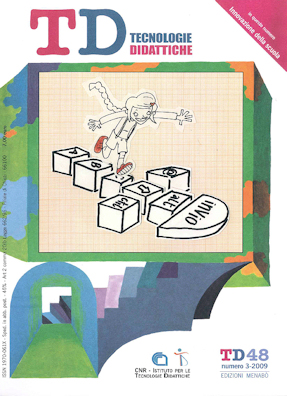Che cosa comporta introdurre nuove tecnologie didattiche a scuola : un modello
Contenuto principale dell'articolo
Abstract
Dettagli dell'articolo
Gli autori che pubblicano su questa rivista accettano le seguenti condizioni:
- Gli autori mantengono i diritti sulla loro opera e cedono alla rivista il diritto di prima pubblicazione dell'opera, contemporaneamente licenziata sotto una Licenza Creative Commons CC BY 4.0 Attribution 4.0 International License.
- Gli autori possono aderire ad altri accordi di licenza non esclusiva per la distribuzione della versione dell'opera pubblicata (es. depositarla in un archivio istituzionale o pubblicarla in una monografia), a patto di indicare che la prima pubblicazione è avvenuta su questa rivista.
- Gli autori possono diffondere la loro opera online (es. in repository istituzionali o nel loro sito web) prima e durante il processo di submission, poiché può portare a scambi produttivi e aumentare le citazioni dell'opera pubblicata (Vedi The effect of Open Access).
Riferimenti bibliografici
Anglin G. J. (Ed) (1995). Instructional Technology: Past, present, and future. Englewood, CO: Libraries Unlimited.
Antonietti A., Colombo B. (2008). Computer-supported learning tools: A bicircular bi-directional framework. New Ideas in Psychology, 26, pp. 120- 142.
Boekaerts M., Pintrich P. R., Zeidner M. (Eds.) (2000). Handbook of self-regulation. San Diego, CA: Academic Press.
Breton. (2001). Le culte de l’Internet. Paris: La Découverte.
Bryant J., Zillman D. (Eds.) (2002). Media effects. Advances in theory and research. Mahwah, NJ: Lawrence Erlbaum Associates.
Dinet J., Marquet P., Nissen E. (2003). An exploratory study of adolescent’s perceptions of the Web. Journal of Computer Assisted Learning, 19, pp. 538-545.
Eilon B., Kliachko S. (2004). Perceptions of the teacher’s role by prospective elementary school science teachers in a Web-based biology course. Journal of Technology and Teacher Education, 12, pp. 339-360.
Gao T. (2003). The effects of different levels of interaction on the achievement and motivational perceptions of college students in a Web-based learning environment. Journal of Interactive Learning Reasearch, 14, pp. 367-386.
Gordon M., Killey M., Shevlin M., McIlroy D., Tierney K. (2003). The factor structure of the Computer Anxiety Rating Scale and the Computer Thoughts Survey. Computer in Human Behavior, 19, pp. 291-298.
Jiang M., Ting E. (2000). A study of factors influencing students’ perceived learning in a Web-based course environment. International Journal of Educational Telecommunications, 6, pp. 317-338.
Kozma R. B. (1994). Will media influence learning? Reframing the debate. Educational Technology Research and Development, 7, pp. 19-42.
Madell D., Muncer S. (2004). Back from the beach but hanging on the telephone? English adolescents’ attitudes and experiences of mobile phones and the Internet. Cyber Psychology and Behavior, 7, pp. 359-367.
Mimirinis M., Bhattacharya M. (2007). Design of virtual learning environments for deep learning. Journal of Interactive Learning Research, 18, pp. 55-64.
Munneke L., Andriessen J., Kanselaar G., Kirschner P. (2007). Supporting interactive argumentation: Influence of representational tools on discussing a wicked problem. Computers in Human Behavior, 23, pp. 1072-1088.
Narciss S., Proske A., Koerndle H. (2007). Promoting self-regulated learning in web-based learning environments. Computers in Human Behavior, 23, pp. 1126-1144.
Newby T., Stepich D., Lehman J., Russell J. (2000). Instructional Technology for teaching and learning: Designing instruction, integrating computers, and using media. Columbus, OH: Prentice-Hall.
Olimpo G. (1993). Nascita e sviluppi delle tecnologie didattiche. Tecnologie Didattiche, 1, pp. 23-34.
Saadé R. G., He X., Kira D. (2007). Exploring dimensions to online learning. Computers in Human Behavior, 23, 1721-1739.
Salomon G. (1993). On the nature of pedagogic computer tools: The case of the writing partner. In S. P. Lajoie, S. J. Derry (Eds), Computer as cognitive tools. Hillsdale, NJ: Erlbaum, pp. 179-196.
Selwyn N. (1997). Students’ attitudes toward computers: Validation of a computer attitude scale for 16-19 education. Computer and Education, 28, pp. 35-41.
Wang D., Lin S.S.J., Sun C. (2007). DIANA: A computer-supported heterogeneous grouping system for teachers to conduct successful small learning groups. Computers in Human Behavior, 23, pp. 1997-1010.
Wilson T., Whitelock D. (1998). What are the perceived benefits of participating in a computer-mediated communication (CMC) environment for distance learning computer science students? Computers and Education, 30, pp. 259-269.
Xiao L., Carroll J. M. (2007). Fostering an informal learning community of computer technologies at school. Behaviour and Information Technology, 26, pp. 23-26.
Yaghi H. M. (1997). Pre-university students’ attitudes toward computers: An international perspective. Journal of Educational Computing Research, 16, pp. 237-249

